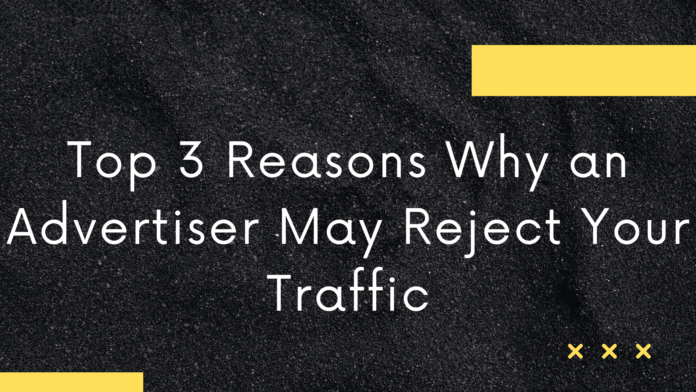Hello everyone!
This is Gambling.pro. Today I will discuss several reasons why an advertiser may fully or partially reject traffic, or lower the rate for traffic already poured.
Currently, Gambling.pro collaborates with hundreds of advertisers and has more than 3000 offers with various conditions in gambling and betting verticals. Based on this, we have accumulated a huge wealth of knowledge and invaluable experience, which I will share with you in this article.
Let’s get started!
Reason #1. Violation of offer conditions.
This is one of the most common mistakes among beginner arbitrators. If the traffic does not meet the offer conditions, the advertiser is entitled to not fully or partially pay for it. In this situation, we always try to negotiate and find a compromise, but the fact of violation remains a fact, and the decision on traffic payment is always up to the advertiser.
This is what the conditions look like in each of our offers:
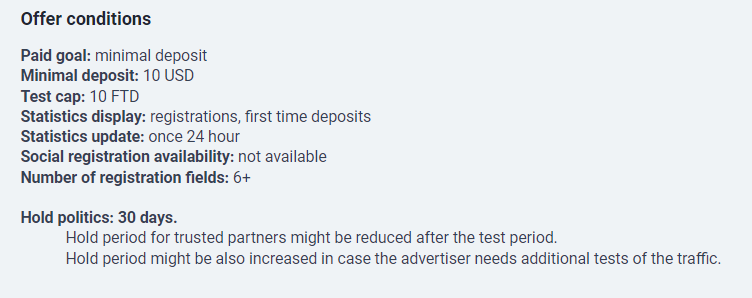
In each offer, we specify not only conditions but also recommendations for pouring, which should be adhered to.
If all the points of recommendations are met, the likelihood that your traffic will pass all the main conditions and KPIs of the advertiser greatly increases.
Recommendations will help improve traffic quality and reduce the likelihood of disputes.
This is what the general conditions and recommendations look like in each of our offers:
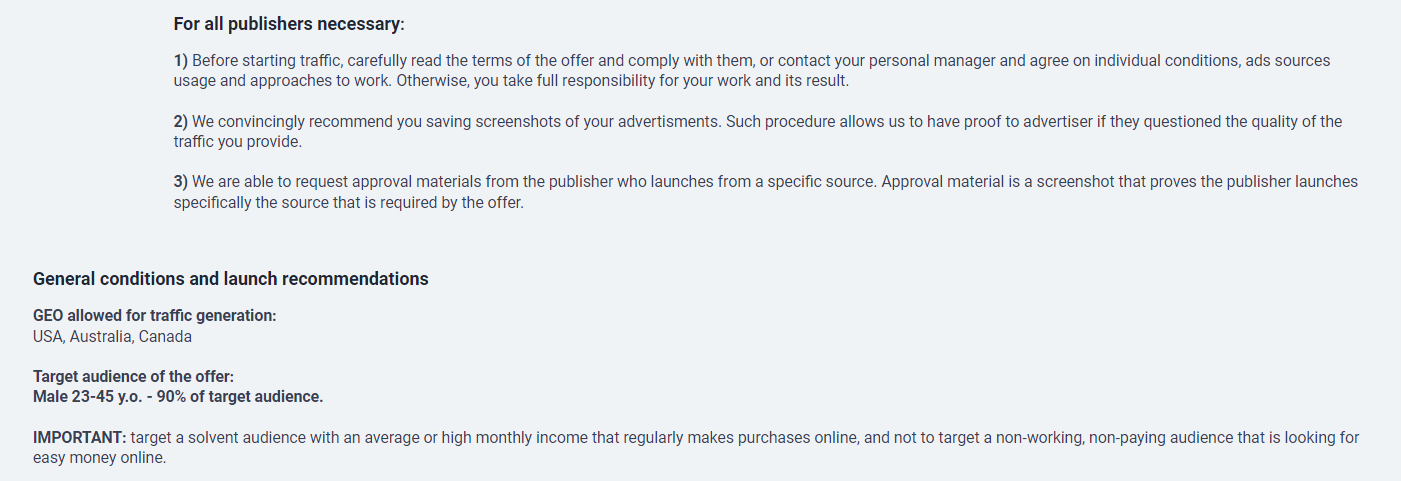
Note: Always read the conditions specified in the offer. If anything is unclear, it is better to seek help from a personal manager.
Let’s examine the key points of offer conditions, the non-fulfillment of which threatens complete or partial rejection of payment:
- Payable goal in the offer.
One of the main conditions of the offer, which should always be paid attention to!
Let’s consider a situation:
Suppose you poured 40 FD into offer X at a rate of $35 for geo BR. The payable goal on this offer is a minimum deposit of 25BRL + KPI: a deposit made no later than 7 days from the date of registration. If 15 out of 40 deposits were made more than 7 days after user registration, they will be rejected for failing to meet the KPI. But, in this case, there is always a chance to negotiate with the advertiser for payment if the traffic was really good.
Therefore, always pay attention to the key condition – the payable goal, as it is primary.
- Uncoordinated traffic source.
Imagine that you are pouring from context by general keywords of one of the offers and decided to simultaneously pour context on the brand or cross-brand. If the advertiser does not initially accept context on the brand or cross-brand, in the best case, you will get off with a warning, in the worst case – the advertiser will reject all traffic and no longer connect you to the offer. It is very important to coordinate a particular traffic source before starting to work with an offer, to avoid misunderstandings. Advertisers are different, and not all of them are accommodating. In this case, it is better not to hope for the possibility of negotiating and discuss all the nuances of working with the offer in advance!
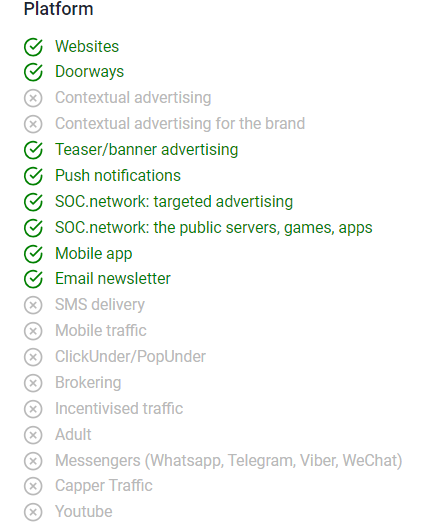
- Test cap on the offer.
Cap – a limited number of conversions that the advertiser gives out for a test pour.
Each advertiser conducts an assessment of the quality of traffic poured on his offer. Typically, the average number of first deposits required for adequate traffic analysis is 20 FD (First Deposit). If the number of conversions turns out to be less than this value, then it will be more difficult to determine the quality of the traffic. The size of the test cap allocated by the advertiser is indicated in the conditions of each offer.
Also, if there is an overflow of the test cap, the advertiser is entitled to lower the rate for these conversions or completely reject the traffic that exceeded the test volume, as this violates the agreed working conditions and the allocated budget was not calculated for additional payment.
- Allowed geo for pouring.
Geo – the country to which the offer is agreed with the advertiser for pouring traffic from certain advertising sources.
For each geo, specific working conditions and rates are discussed when agreeing on an offer. If the attracted traffic does not correspond to the permitted country in the offer, then the advertiser may pay for it at a lower rate or reject it altogether. In each offer, we indicate specific targeting for pouring traffic.

Reason #2. Traffic not subject to payment.
- Motivated traffic.
Typically, this type of traffic includes people motivated by earnings for performing certain target actions required by the conditions of the offer being poured. Most often, such traffic is poured using phrases in creatives that motivate people to make deposits.
Example: “Deposit $5 – you’ll get $10 from me on your card.”
Such traffic is not valued, as it does not bring any profit.
Traffic from paid-to-click sites can also be attributed to this point, as these users simply perform a sequence of actions
for payment on a certain service. They are definitely not the target audience.
Any motivation of users who will not bring profit in the long run will not be welcomed.
- Schemed/Capper traffic.
Let me clarify right away: we are talking about offers where these traffic sources are prohibited.
The essence of such pouring is that users are motivated by earnings through casino gaming (schemes) and sports event predictions (capping). These traffic sources do not pay off at standard rates, as player activity is maintained for a limited time, and the amounts of deposits, depending on the geo, can be significantly lower than the payment for the offer accepting traffic from other sources.
But there are separate offers for schemed or capper traffic, to which this point does not apply.
- Mislead.
Mislead is an action where the user is misled due to incorrect information from the creative.
For example, a non-existent bonus is indicated in the creative. Such players, as a rule, do not show proper activity on the product. Also, users may write to the online support of the product about a bonus that does not exist, and the advertiser will lose reputation, which is a huge minus. It is important to understand that when a deceived player contacts support, the advertiser will clearly know from which arbitrator the player came, thanks to the trail of ref. links.
- Multi-accounts.
Multi-accounts are the artificial multiplication of gaming accounts on the advertiser’s product. Users create a new account by clicking on a link in an advertisement, while already having an account on the product.
The advertiser is interested in attracting new players to their product and will not pay for users who already have an account or were registered earlier. Moreover, old players are attracted by the product itself or someone else’s already paid advertising.
- Chargebacks.
Chargeback is an attempt to dispute a payment made with the aim of its return. This can occur if unreliable information is indicated in creatives. Players experience negativity due to deception and want to get their money back. There are frequent cases when a player simply did not like the product and decided to return their own money, as they no longer want to play here.
If players return money during the hold period, then the advertiser does not earn anything on this, so these users are not paid.
- Self-exclude.
Self-exclude is a ban on access to online casinos, closing an account, or restrictions on deposits for a specific player at their own initiative. This phenomenon is common in foreign casinos. Since attracted users may limit themselves from playing at their own will, such traffic has absolutely no value and is not subject to payment.
- Inactive traffic.
Simply put, this is traffic that does not show any activity after registration or making a few deposits.
Consider a situation where the payable goal is “minimum deposit” without additional KPIs.
You, adhering to all the conditions of the offer, poured a certain number of first deposits. Each advertiser checks the traffic over a certain period of time. Typically, this can take from 2 days to 2 months. In other words, all leads are sent to hold. At this point, the advertiser looks at the amounts of the first deposits, repeat deposits, average player checks on the product, and other activity of the attracted users. If, after the expiration of the hold period, the traffic does not show activity after the first few deposits, the advertiser may extend the hold, and its check will be delayed for at least another reporting period. This can lead to a reduction in the payment for the already poured traffic and a decrease in the rate for the offer for further work.
Also, it is not excluded that the advertiser may completely or partially reject the traffic, but we try not to allow such situations and minimize them.
Recommendation: carefully monitor the quality of your traffic, otherwise you may waste time and money in vain.
Reason #3. Fraud.
This activity is easily detected, as almost all advertisers have their own automatic “anti-fraud” system and more detailed manual checks by specialists. If the brought traffic is suspected of fraud and there is no evidence of attracting this traffic from allowed sources, it is usually rejected without the possibility of reviewing the decision, as no one will pay for non-existent players.
Thus, it is not acceptable to work this way. In the event of detection and proof of such actions, we block the account in our CPA network forever.
All this information is stated in each offer:
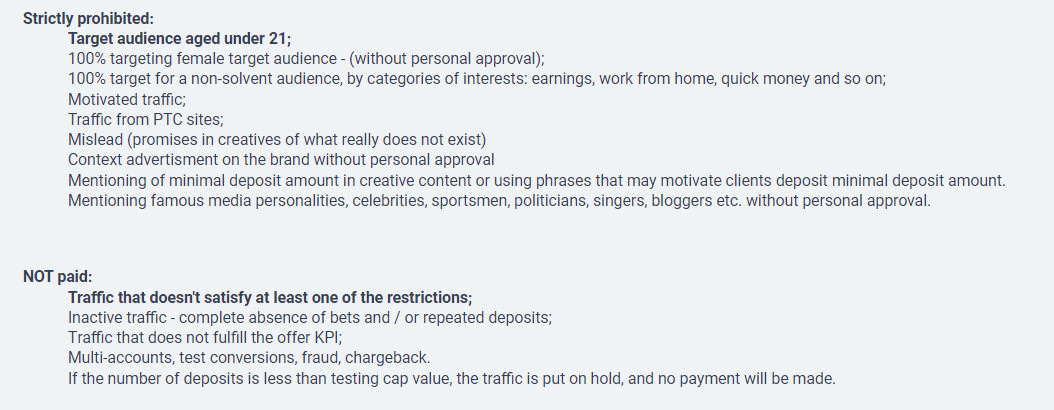
Conclusion:
Sure, here’s the translation of your text from Russian to English:
Reductions in payouts for attracted traffic are rare for those who do not violate offer conditions and strive to work honestly. By sacrificing traffic quality in pursuit of elusive thousands of percent ROI, you risk not receiving any payment and, consequently, only losing time.
Everyone makes their own choice, but if you are counting on long-term work with the advertiser or affiliate program – the choice is obvious!
Well, about how to get 100% approval of traffic, increase rates up to 70%, and much more, I will tell you in the next article – follow our blog GamblingPro!
Thank you for your attention!
Wishing everyone successful campaigns and high ROI! 👑

